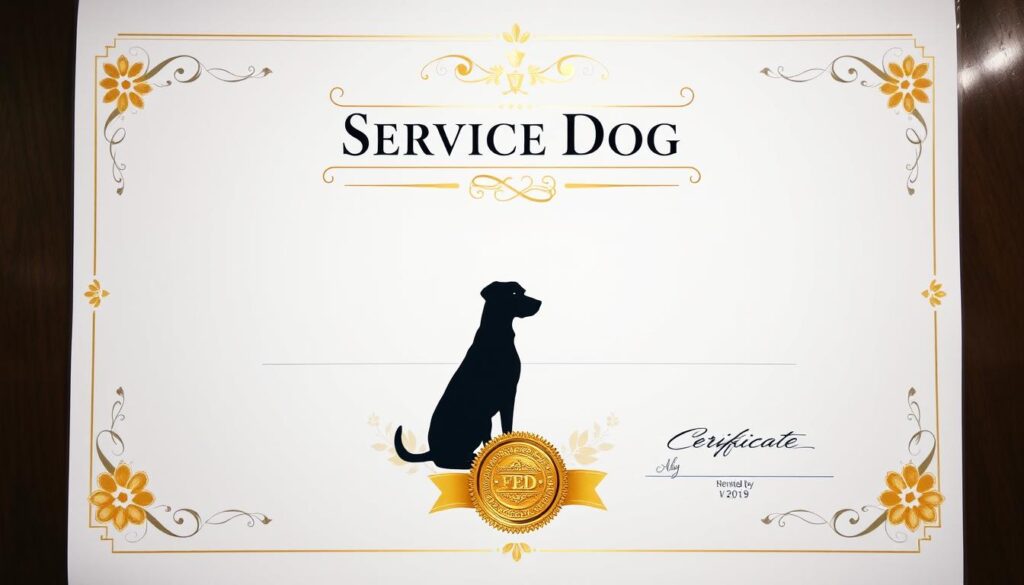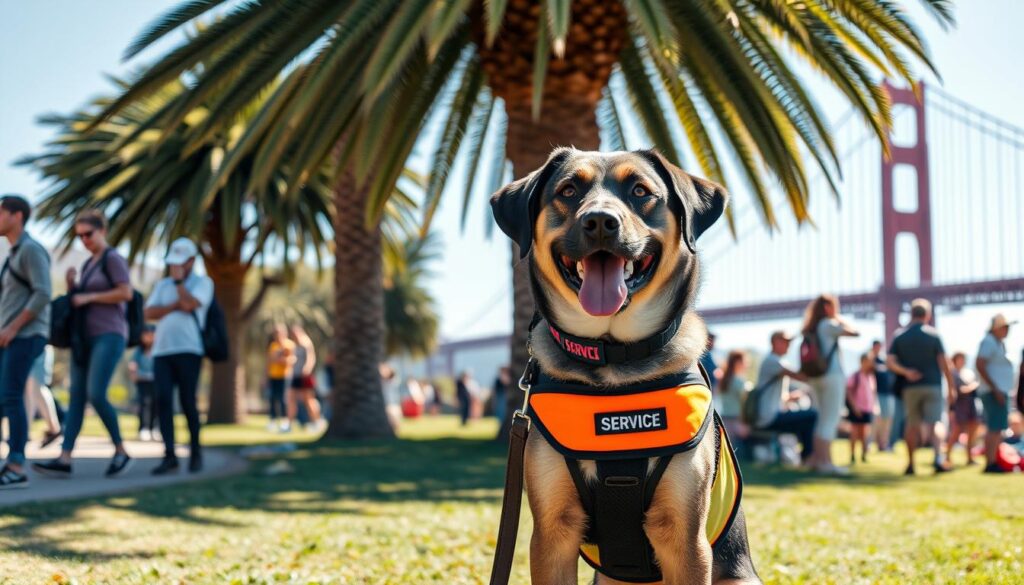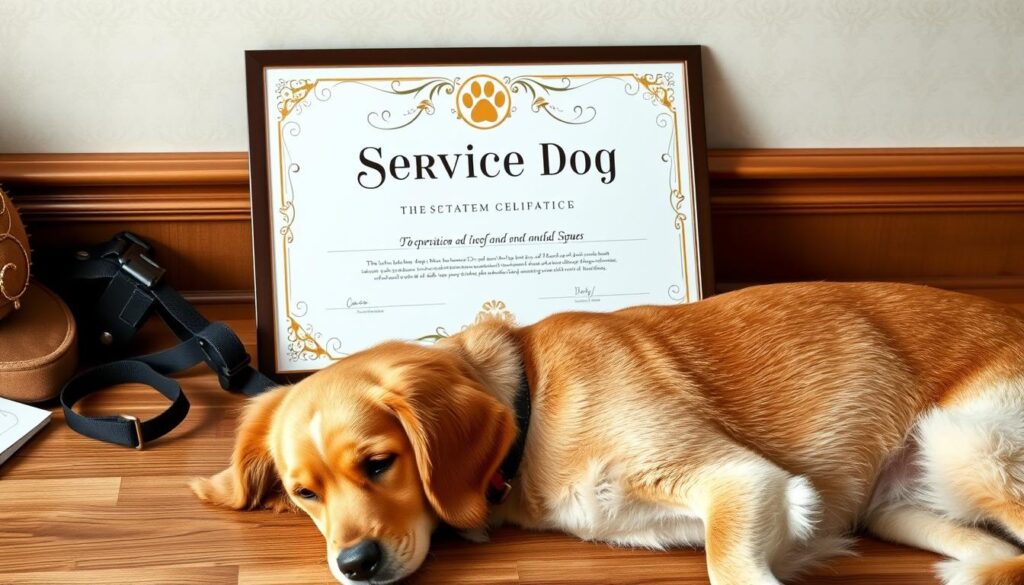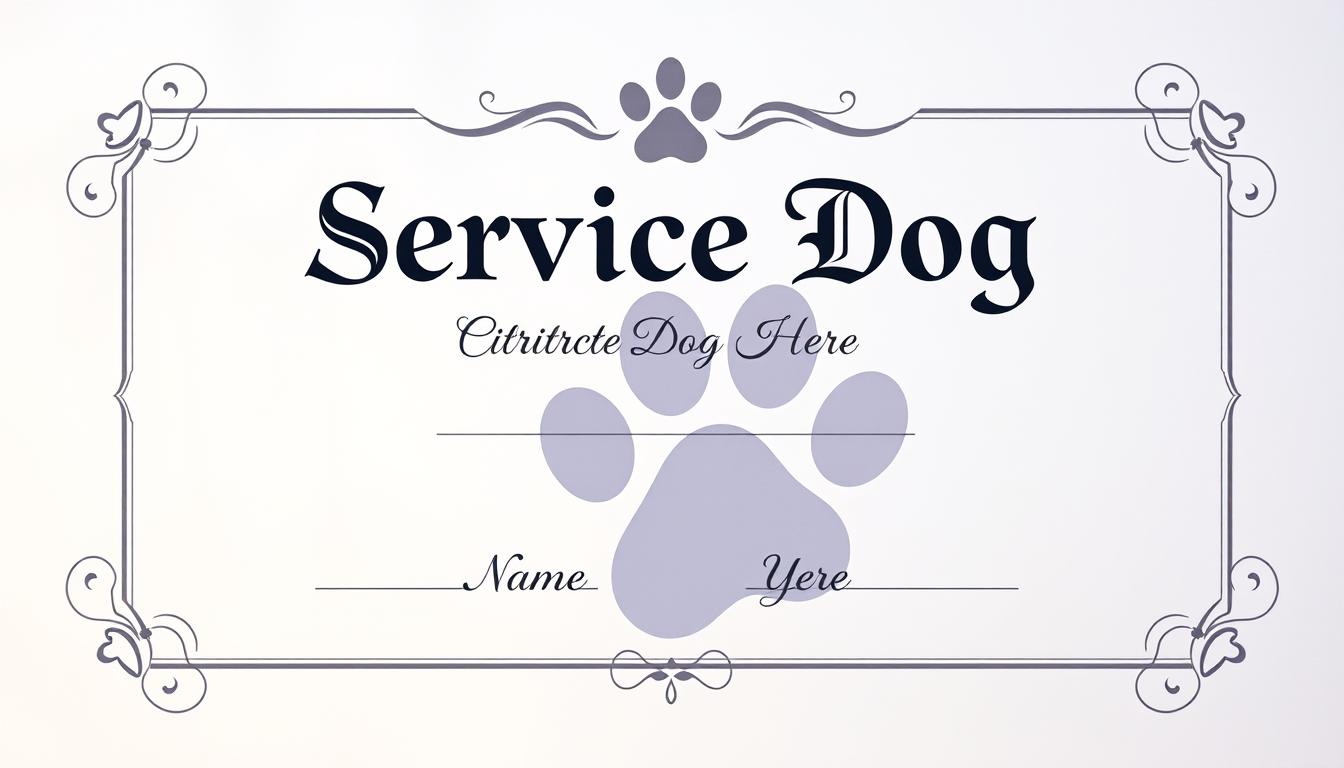Living with a disability, I’ve seen how much a service dog can change your life. They help with mobility, alert you to health issues, and offer emotional support. Getting a service dog certificate can seem hard, with lots of legal stuff and high standards. But don’t worry, I’m here to walk you through it, step by step. We’ll get you the official papers for your service dog.
Key Takeaways
- The ADA defines service dogs as those individually trained to perform tasks or do work for a person with a disability.
- Disabilities can include physical impairments as well as mental illnesses that substantially limit major life activities.
- Service dogs have specific legal rights and are allowed in public places, including businesses, transportation, and housing.
- Comprehensive training and public access testing are required before a dog can be considered a fully certified service animal.
- Specialized accessories and identification can facilitate interactions with the public and communicate your dog’s service status.
What is a Service Dog and Who Qualifies?
A service dog is a dog trained to help someone with a disability. The Americans with Disabilities Act (ADA) says people with physical, emotional, or mental health issues can have a service dog. The dog must be trained to help with specific needs related to the disability.
Service Dog Definition and Requirements
The ADA says a service dog is a dog trained to help someone with a disability. This means the dog must be trained to do specific tasks. For example, it might help with balance, alerting to changes in blood sugar, or getting medication.
It’s important to know that the ADA doesn’t require service dogs to be professionally trained. People with disabilities can train their own service dogs. The only rules are that the dog must be under the handler’s control and not be a danger to others.
Related: how to make your dog a service dog: A Complete Guide
Qualifying Disabilities for Service Dogs
- Physical disabilities like arthritis, multiple sclerosis, or epilepsy
- Mental health conditions such as generalized anxiety disorder, panic disorder, or social anxiety disorder
- Sensory disabilities like blindness or deafness
- Neurological disorders like autism or traumatic brain injury
To qualify, a person’s disability must affect their daily life. The service dog must be trained to help with specific tasks. For example, a psychiatric service dog might interrupt harmful behavior or provide calming therapy.
If someone asks, the handler can answer two questions: (1) Is the dog required due to a disability? and (2) What tasks is the dog trained to perform? The handler doesn’t need to show proof or have the dog demonstrate its tasks.
Training Your Service Dog
To be a Service Dog, your dog must learn a specific job to help you. In the U.S., there’s no one group that sets rules for training. But, the Americans with Disabilities Act (ADA) lets you train your dog yourself.
Tasks and Work Related to Your Disability
Teach your Service Dog a skill that helps with your disability. This could be guiding someone who can’t see, alerting to seizures, getting things, or spotting dangers. Service dogs greatly improve the lives of their owners by doing these tasks.
Recommended Training Duration and Public Exposure
In the U.S., there’s no set time for training. But, some say about 120 hours over six months is good. Spend at least 30 hours in public places. This helps your dog get used to distractions and surprises.
“Service dogs provide invaluable support and independence for individuals with disabilities. The dedication and hard work put into their training is truly remarkable.”
For a Service Dog to be great, train them for your specific needs. Make sure they’re ready to help you every day.
Passing a Public Access Test
To make sure your service dog can move easily in public, they need a tough public access test. This test checks if they can act right in different places, like when entering buildings or eating in restaurants. It usually takes about 120 hours of training over six months for dogs six months or older.
The test includes many parts, like getting out of cars, entering buildings, and acting right in restaurants. Your service dog must get at least 80% on the “always” or “most of the time” criteria to pass. This means they can stay calm and focused, even when things get loud or busy.
Even though the public access test is important, the Americans with Disabilities Act (ADA) doesn’t require it. The ADA just says service dogs must be trained to help with their owner’s disability.
“A service dog should be able to work calmly and quietly on a public access test. This shows they’re well-trained and can handle busy places.”
When your service dog passes the public access test, they’re ready to go with you in public. They’ll help you while acting right. This helps you and also builds trust and understanding of service dogs’ important role in our lives.
Service Dog Certificate
In the United States, you don’t need a service dog certificate to have a service dog. Places open to the public can’t ask for proof that your dog is certified. Yet, many places still ask for an ID or other proof that your dog is a service animal.
Purpose of Service Dog Certification
Having a custom Service Dog ID card and Vest can help you and your dog in public. These tools show your dog’s role and your right to have them with you. Training a service dog can cost up to $25,000, including education for the owner.
Verification Requirements Under ADA
The Americans with Disabilities Act (ADA) lets businesses ask only two questions about service animals. They can ask if the dog is a service animal because of a disability and what tasks the dog has been trained for. They can’t ask for proof of training or certification.
| Breed | Popularity for Service Dogs |
|---|---|
| German Shepherds | Used to be the most popular, but now less common |
| Golden Retrievers | One of the most common breeds for service dogs |
| Labradors | One of the most common breeds for service dogs |
| Australian Shepherds | One of the most common breeds for service dogs |
| Boxers | One of the most common breeds for service dogs |
Even though you don’t need a service dog certificate, it can still be useful. Businesses can only ask a few questions about your service dog under the ADA. They can’t ask for proof of training or certification.

Psychiatric Service Dogs and Emotional Support Animals
Psychiatric service dogs (PSDs) and emotional support animals (ESAs) are vital for people with mental health issues. They offer comfort and help, but differ in legal rights and tasks.
Qualifying Mental Health Conditions
To get a PSD, you need a mental health issue that really limits your life, as the ADA says. This includes PTSD, anxiety, depression, OCD, and autism spectrum disorder.
Tasks Performed by Psychiatric Service Dogs
PSDs are trained to do specific tasks for their handler’s mental health. They might apply deep pressure, get meds, lead the owner out of stressful places, or stop self-destructive habits. They have the same rights as other service animals under the ADA.
| Psychiatric Service Dogs | Emotional Support Animals |
|---|---|
| Perform specific tasks related to the handler’s mental health condition | Provide general comfort and support, but do not have the same legal rights as service animals |
| Protected under the Americans with Disabilities Act (ADA) | Not covered under the ADA, but may be allowed in housing under the Fair Housing Act |
| Can accompany their handler in public places | No longer allowed to fly with their handlers on commercial flights as of 2021 |
Emotional support animals offer comfort and friendship but lack the legal protections of PSDs. It’s key to know the differences between these animals for mental health support.
California Service Dog Laws and Regulations
California has strict laws for service dogs. As a Golden State resident, your rights are protected. The Americans with Disabilities Act (ADA) and California’s Unruh Act ensure service dogs have access and inclusion.
Service Dog Access Rights in California
In California, service dogs are dogs trained to help people with disabilities. They can go anywhere, like restaurants and stores. People with service dogs can live and travel freely without facing discrimination.
California’s laws are different from the ADA in one key way. The state also protects service dogs in training. While the ADA only covers trained service dogs, California’s laws include dogs still learning.
| Service Dog Access Rights in California | Emotional Support Animals in California |
|---|---|
|
|
Emotional support animals (ESAs) are different. They offer great support but don’t have the same rights as service dogs. ESAs are only protected under the Fair Housing Act, not in public places.

Prerequisites for Training a Service Dog
Training a service dog is a big responsibility. It’s rewarding but also challenging. Before starting, there are important steps to take to prepare your dog for public life.
Socialization and Obedience Training
Service dogs go everywhere with their handlers. They need to be socialized and exposed to many places. Early socialization is key to their success.
Start taking your puppy to different places like stores and parks. This helps them get used to new environments. Service dogs also need to stay calm around other animals. That’s why some breeds are not good for service work.
While service dogs don’t need a special obedience course, formal training is a good idea. They must be well-behaved in public. Learning basic commands like “sit” and “stay” helps them focus and follow you.
Recommended Breed Temperaments
Not all dogs are right for service work. Service dogs should be calm, gentle, and eager to please. Breeds like Labradors, Golden Retrievers, and Poodles are often chosen for their intelligence and trainability.
It’s best to avoid high-energy or fearful breeds. This ensures your service dog is reliable and trustworthy.
| Recommended Service Dog Breeds | Breed Temperament |
|---|---|
| Labrador Retriever | Gentle, intelligent, and eager to please |
| Golden Retriever | Friendly, loyal, and adaptable |
| Standard Poodle | Intelligent, calm, and hypoallergenic |
Service Dog Certificate
Registering your service dog with a group like Service Dog Certifications adds their info to a database. This can give you an ID card to show others your dog is a service dog. But, remember, the Americans with Disabilities Act (ADA) doesn’t need an ID for service animals. Their rights to be in public places don’t depend on an ID.
A service dog certificate can be useful, but it’s not required by law. The ADA looks at what the dog can do, not if they have papers. If your service dog is well-trained and helps you with your disability, they can go with you in public. This is true even without a certificate.
| Service Dog Identification | Service Dog Certification |
|---|---|
| An ID card that can be presented as proof of your service dog’s status | Formal registration of your service dog with an organization, providing a searchable database entry |
| Not legally required under the ADA | Not legally required under the ADA |
| Can be helpful in situations where others are unaware of service dog laws | Can provide an additional level of documentation, but not necessary for access rights |
The key things are your service dog’s training and behavior, not if they have a certificate. Make sure your dog is well-behaved and can do the tasks needed to help you. Then, you can confidently use your service dog’s rights under the ADA.

“At least half a million Americans rely on service dogs as essential accessibility and healthcare tools.”
Knowing Your Rights as a Service Dog Handler
In California, service dog handlers have many rights under the Americans with Disabilities Act (ADA). These rights allow you to bring your service dog into public places, outdoor areas, public transport, and even airplane cabins. It’s key to know your rights and those of your service animal to handle any issues that come up.
The ADA says businesses can’t ask you to show what your dog does or ask about your disability. They can only ask if your dog is a service animal and what it’s trained to do. This rule helps you and your dog get the access you need while keeping your privacy.
Service dogs must always be controlled by their handler. Emotional support animals (ESAs) don’t count as service animals under the ADA. But, ESAs might be covered under the Fair Housing Act (FHA) for housing. Still, ESAs don’t have the same rights as service dogs to go into public places.
Being a service dog handler comes with its own set of rules and rights. Knowing what you’re entitled to can help you stand up for yourself and your dog. In California, service dog handlers have strong protections. Understanding these can help you get the most out of your service dog’s help.
| Service Dog Handler Rights | ADA Rules |
|---|---|
| Public Access | Service dogs must be allowed in venues, outdoor areas, and on public transportation. |
| Airline Travel | Service dogs are permitted to accompany their handlers in the cabin of airplanes. |
| Disability Inquiries | Businesses can only ask if the dog is a service animal and what tasks it is trained to perform. |
| Handler Control | Service dogs must always be under the control of their handler. |
As a service dog handler, you have the right to take your dog into public spaces and on transport. Knowing your rights can help you deal with any problems. It ensures you and your service dog get the help you need.
Conclusion
Training a service dog is a big job that needs a lot of work. Dogs must know how to follow commands and do a special task for their handler. Even though they don’t need a special certification, getting them trained is a good idea.
This training makes sure your service dog can do their job well. If you have questions, talk to your vet for help.
Training a service dog is tough, but it’s worth it. You’ll get a loyal friend who makes your life better. Make sure your dog is ready for their job by following the right steps.
Stay patient and keep working hard. You’ll soon have a great service dog team.
A good service dog partnership needs training, certification, and knowing your rights. Keep learning, ask for help when you need it, and work with your dog. This way, you can make your life better with your service dog.

